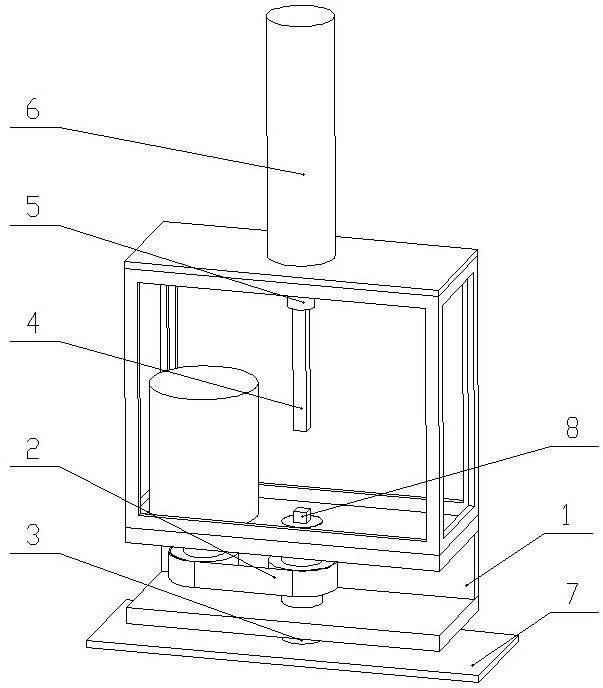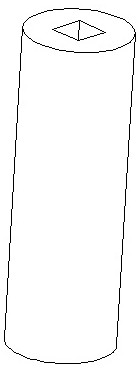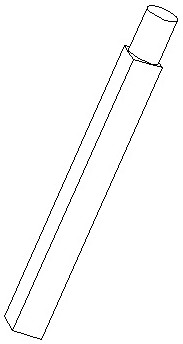Friction welding material adding equipment and method
A friction welding and equipment technology, applied in the field of additive manufacturing, can solve the problems of friction heat generation between the piston and the rod body, poor fusion, and reduce the overall performance, so as to improve the utilization rate of materials, reduce the extrusion force, and improve the production efficiency. Effect
- Summary
- Abstract
- Description
- Claims
- Application Information
AI Technical Summary
Problems solved by technology
Method used
Image
Examples
Embodiment 1
[0049] Such as Figure 1~Figure 4 As shown, a friction welding additive equipment includes a machine base 1, a rotating device 2, a shaft shoulder 3, an extrusion rod 4, a shaft sleeve 5, and an extrusion device 6.
[0050] The rotating device 2 is installed on the machine base 1 and includes a motor and a pulley drive. The motor drives the pulley to drive the shaft shoulder 3 to rotate, and the rotation speed of the shaft shoulder 3 is adjustable from 100 to 2000 r / min.
[0051] The shaft shoulder 3 has a through hollow inner cavity, and the section of the hollow inner cavity is a through square.
[0052] The extrusion rod 4 moves in the hollow cavity of the shaft shoulder 3, and the section shape of the part of the extrusion rod 4 inserted into the hollow cavity of the shaft shoulder 3 is square, and the extrusion rod 4 cooperates with the square hollow cavity of the shaft shoulder 3, The shaft shoulder 3 can rotate with the extrusion rod 4 when it rotates.
[0053] The sh...
Embodiment 2
[0058] The specific implementation process includes the following implementation steps:
[0059] S1. Move the device down so that the shoulder 3 contacts the surface of the substrate 7 to be added;
[0060] S2, putting the base material 8 into the hollow inner cavity of the shoulder 3;
[0061] S3, the extrusion device 6 drives the bushing 5 to drive the extrusion rod 4 to move downward, and inserts it into the hollow inner cavity of the shaft shoulder 3;
[0062] S4. The rotating device 2 drives the shaft shoulder 3 to rotate, drives the base material 8 and the extrusion rod 4 to rotate synchronously, the base material 8 and the matrix 7, and the shaft shoulder 3 and the matrix 7 rub against each other to generate heat to soften the base material 8 and the matrix 7;
[0063] S5. The extrusion device 6 continues to drive the bushing 5 to drive the extrusion rod 4 to move downward to give the base material 8 downward extrusion force, extruding the softened base material and sp...
Embodiment 3
[0066] In the specific implementation process, it can also be realized through the following implementation steps:
[0067] S1. Move the friction welding additive equipment down so that the end face of the shaft shoulder is higher than the surface of the substrate to be additive by a certain height, and the height is 0.5mm~5mm;
[0068] S2, putting the base metal into the hollow cavity of the shaft shoulder;
[0069] S3. The drive shaft sleeve of the extrusion device drives the extrusion rod to move downward and insert it into the hollow inner cavity of the shaft shoulder;
[0070] S4. The rotating device drives the shaft shoulder to rotate, drives the base material and the extrusion rod to rotate synchronously, and the base material and the base body rub against each other to generate heat to soften the base material and the base body;
[0071] S5. The extrusion device continuously drives the shaft sleeve to drive the extrusion rod to move downward to give the base material ...
PUM
 Login to View More
Login to View More Abstract
Description
Claims
Application Information
 Login to View More
Login to View More - R&D
- Intellectual Property
- Life Sciences
- Materials
- Tech Scout
- Unparalleled Data Quality
- Higher Quality Content
- 60% Fewer Hallucinations
Browse by: Latest US Patents, China's latest patents, Technical Efficacy Thesaurus, Application Domain, Technology Topic, Popular Technical Reports.
© 2025 PatSnap. All rights reserved.Legal|Privacy policy|Modern Slavery Act Transparency Statement|Sitemap|About US| Contact US: help@patsnap.com



